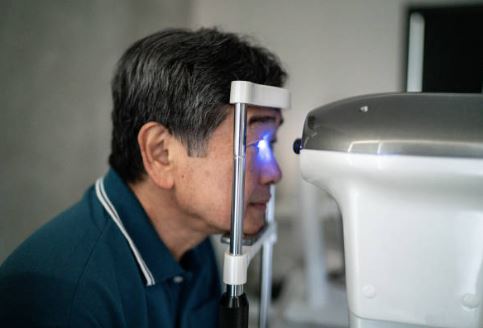A cataract is a clouding of the lens in the eye that causes vision loss. The lens is a clear part of the eye that helps to focus light, or an image, on the retina at the back of the eye. The retina is the light-sensitive layer of tissue at the back of the eye that converts light into electrical signals and sends them to the brain. When the lens is cloudy, it blocks some of the light that would normally pass through it and reach the retina, which can cause vision loss.

Cataracts are most commonly associated with aging, but they can also be caused by other factors such as injury, certain medications, or certain medical conditions. Cataracts are usually treated with surgery to remove the clouded lens and replace it with an artificial lens. This can improve vision and help to restore normal vision.
The most common symptom of a cataract is blurry vision. Other symptoms may include seeing halos around lights, difficulty reading or seeing at night, and needing brighter light to see clearly. Some people with cataracts may also experience double vision or a change in the way they perceive colors.
Treatment for cataracts typically involves surgery to remove the cloudy lens and replace it with an artificial lens, called an intraocular lens (IOL). This procedure is usually performed by an ophthalmologist, a doctor who specializes in the medical and surgical treatment of the eyes. The surgery is typically performed on an outpatient basis, which means that the patient can go home the same day.
Before surgery, the ophthalmologist will perform a thorough examination of the eye to determine the size and location of the cataract and to assess the overall health of the eye. The ophthalmologist may also take measurements of the eye to determine the best type of IOL to use.
During the surgery, the ophthalmologist will make a small incision in the eye and use special tools to remove the cloudy lens. The IOL is then inserted into the eye through the same incision. The incision is usually so small that it does not require sutures (stitches).
After the surgery, the ophthalmologist will provide instructions for care, including the use of eye drops to help prevent infection and inflammation. Most people experience a significant improvement in their vision after the surgery, although some may need additional treatment or surgery to correct any other vision problems.
Cataract surgery is generally considered safe and effective, with a high success rate. However, as with any surgery, there is a risk of complications, such as infection, bleeding, or inflammation. The ophthalmologist will discuss the potential risks and benefits of the surgery with the patient before the procedure is scheduled.
Preventing cataracts is not always possible, but there are some measures that may help to reduce the risk. These include wearing sunglasses or a hat to protect the eyes from UV light, maintaining good blood sugar control if you have diabetes, and avoiding smoking. In addition, eating a healthy diet that includes foods rich in antioxidants, such as fruits and vegetables, may also help to lower the risk of cataracts.
In conclusion, a cataract is a clouding of the lens in the eye that can cause blurry vision and other visual disturbances. Treatment typically involves surgery to remove the cloudy lens and replace it with an artificial lens. Cataract surgery is generally safe and effective, but as with any surgery, there is a risk of complications. Taking steps to protect the eyes from UV light, maintaining good blood sugar control if you have diabetes, and avoiding smoking may help to


